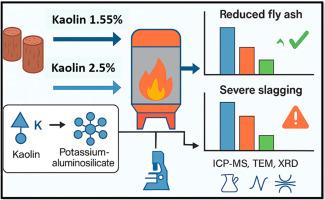在250kw炉排锅炉上,高岭土对生物质燃料燃烧灰分分配和结渣的影响
IF 5.8
2区 生物学
Q1 AGRICULTURAL ENGINEERING
引用次数: 0
摘要
炉排锅炉传热区结渣、结灰等与灰有关的问题一直是影响炉排锅炉安全高效运行的重要问题。这些问题必须得到解决,以避免由于在燃烧过程中未能控制结块和结渣而导致任何意外停机。人们提出了各种方法,如在炉排锅炉中注入化学添加剂,以减少燃烧过程中底灰中的碱种和传热区的沉积。然而,以往人们对添加高岭土时锅炉工况尤其是炉膛工况的影响认识不清。因此,本研究的目的是从实验和理论两方面研究生物质燃料与高岭土混合对250kw炉排锅炉灰分相关问题的影响。研究发现,在烧制条件下,高岭土粉末作为钾的吸附剂表现得相当有效。在燃料混合物中加入高岭土后,粉煤灰的沉积倾向至少降低了50%。然而,当燃料混合物中加入高岭土时,炉排锅炉燃烧室中的结块程度增加。在炉排锅炉中,原木和再生木燃料与任何剂量的高岭土混合后均有较高的烧结率。ICP-MS元素分析表明,底灰、炉渣和粗粉煤灰中最主要的元素是二氧化硅,二氧化硅捕获了钾相关物质,促进了炉渣的形成。这也可以通过x射线衍射(XRD)分析证实,在两种燃料混合物的晶体结构中观察到高浓度的二氧化硅。此外,根据XRD分析和热力学平衡模型预测,在原料中添加高岭土会显著影响底灰中晶体结构的形成,如Kalsilite、Leucite、Sanidine等的形成。本文章由计算机程序翻译,如有差异,请以英文原文为准。

Effect of kaolin on ash partitioning and slagging for the combustion of biomass fuels in a field-scale 250 kW grate boiler
Ash-related issues such as slagging and ash deposition in the heat transfer region of the grate boiler have been considered serious problems for safe and efficient operation. These issues must be addressed to avoid any unplanned shutdown due to failure in controlling the agglomeration and slagging during combustion. Various methods have been proposed, such as the injection of chemical additives into the grate boiler to reduce the alkali species in the bottom ash and depositions in the heat transfer region during combustion. However, the impacts of the boiler condition especially the bed conditions of the grate boiler have not been understood well in the past when adding the kaolin. Therefore, the aim of this work is to investigate, both experimentally and theoretically, the effects of blending biomass fuels with kaolin on ash-related issues in a 250 kW field-scale grate boiler. It was found that the kaolin powder performed quite effectively as an absorbent for potassium under firing conditions. The deposition propensity of fly ash was found to reduce by at least 50 % after the addition of the kaolin to the fuel mixtures. However, an increase in the degree of agglomeration was observed in the combustion chamber of the grate boiler when the kaolin was added to the fuel mixtures. High sintering was observed for the virgin wood and the recycled wood fuel blended with the kaolin at any dosages in the grate boiler. According to the elemental analysis by ICP-MS, the most dominant element found in the bottom ash, slag, and coarse fly ash was silica which captured potassium-related species and promoted the formation of slags. This also can be confirmed by the X-ray diffraction (XRD) analysis which shows that a high concentration of silica in crystalline structures were observed in both fuel mixtures. Moreover, according to the XRD analysis and thermodynamic equilibrium model prediction, adding kaolin to the feedstocks significantly influences the crystalline structure formation in the bottom ash such as the formation of Kalsilite, Leucite, Sanidine and many more.
求助全文
通过发布文献求助,成功后即可免费获取论文全文。
去求助
来源期刊

Biomass & Bioenergy
工程技术-能源与燃料
CiteScore
11.50
自引率
3.30%
发文量
258
审稿时长
60 days
期刊介绍:
Biomass & Bioenergy is an international journal publishing original research papers and short communications, review articles and case studies on biological resources, chemical and biological processes, and biomass products for new renewable sources of energy and materials.
The scope of the journal extends to the environmental, management and economic aspects of biomass and bioenergy.
Key areas covered by the journal:
• Biomass: sources, energy crop production processes, genetic improvements, composition. Please note that research on these biomass subjects must be linked directly to bioenergy generation.
• Biological Residues: residues/rests from agricultural production, forestry and plantations (palm, sugar etc), processing industries, and municipal sources (MSW). Papers on the use of biomass residues through innovative processes/technological novelty and/or consideration of feedstock/system sustainability (or unsustainability) are welcomed. However waste treatment processes and pollution control or mitigation which are only tangentially related to bioenergy are not in the scope of the journal, as they are more suited to publications in the environmental arena. Papers that describe conventional waste streams (ie well described in existing literature) that do not empirically address ''new'' added value from the process are not suitable for submission to the journal.
• Bioenergy Processes: fermentations, thermochemical conversions, liquid and gaseous fuels, and petrochemical substitutes
• Bioenergy Utilization: direct combustion, gasification, electricity production, chemical processes, and by-product remediation
• Biomass and the Environment: carbon cycle, the net energy efficiency of bioenergy systems, assessment of sustainability, and biodiversity issues.
 求助内容:
求助内容: 应助结果提醒方式:
应助结果提醒方式:


